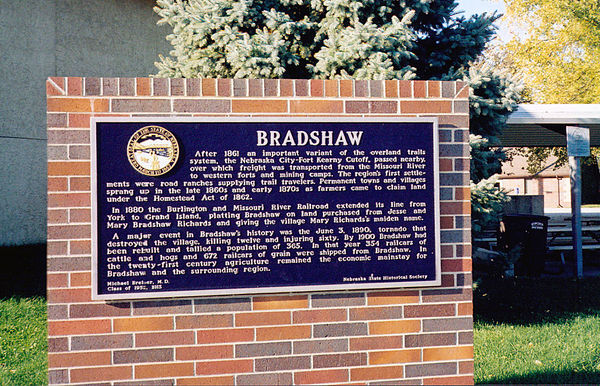Difference between revisions of "Nebraska Historical Marker: Bradshaw"
m |
|||
| Line 4: | Line 4: | ||
455 Lincoln St, Bradshaw, York County, Nebraska | 455 Lincoln St, Bradshaw, York County, Nebraska | ||
| − | View this marker's location '''[https:// | + | View this marker's location '''[https://www.google.com/maps/place/40%C2%B053'01.0%22N+97%C2%B044'51.0%22W/@40.883606,-97.7480602,214m/data=!3m2!1e3!4b1!4m5!3m4!1s0x0:0x0!8m2!3d40.883606!4d-97.747513?hl=en 40.883606, -97.747513]''' |
View a map of all Nebraska historical markers, '''[http://www.nebraskahistory.org/publish/markers/texts/index.shtml Browse Historical Marker Map]''' | View a map of all Nebraska historical markers, '''[http://www.nebraskahistory.org/publish/markers/texts/index.shtml Browse Historical Marker Map]''' | ||
==Marker Text== | ==Marker Text== | ||
| − | ''After 1861 an important variant of the overland trails system, the Nebraska City- | + | ''After 1861 an important variant of the overland trails system, the Nebraska City-Fort Kearney Cutoff, passed nearby, over which freight was transported from the Missouri River to western forts and mining camps. The region's first settlements were road ranches supplying trail travelers. Permanent towns and villages sprang up in the late 1860s and early 1870s as farmers came to claim land under the Homestead Act of 1862. |
| − | Fort Kearney Cutoff, passed nearby, over which freight was transported from the | + | |
| − | Missouri River to western forts and mining camps. The region's first settlements were | + | ''In 1880 the Burlington and Missouri River Railroad extended its line from York to Grand Island, platting Bradshaw on land purchased from Jesse and Mary Bradshaw Richards and giving the village Mary Richards's maiden name. |
| − | road ranches supplying trail travelers. Permanent towns and villages sprang up in the late | + | |
| − | 1860s and early 1870s as farmers came to claim land under the Homestead Act of 1862. | + | ''A major event in Bradshaw's history was the June 3, 1890, tornado that destroyed the village, killing twelve and injuring sixty. By 1900 Bradshaw had been rebuilt and tallied a population of 365. In that year 354 railcars of cattle and hogs and 672 railcars of grain were shipped from Bradshaw. In the twenty-first century agriculture remained the economic mainstay for Bradshaw and the surrounding region. |
| − | ''In 1880 the Burlington and Missouri River Railroad extended its line from York | + | |
| − | to Grand Island, platting Bradshaw on land purchased from Jesse and Mary Bradshaw | + | |
| − | Richards and giving the village Mary Richards's maiden name. | + | |
| − | ''A major event in Bradshaw's history was the June 3, 1890, tornado that destroyed | + | |
| − | the village, killing twelve and injuring sixty. By 1900 Bradshaw had been rebuilt and | + | |
| − | tallied a population of 365. In that year 354 railcars of cattle and hogs and 672 railcars | + | |
| − | of grain were shipped from Bradshaw. In the twenty-first century agriculture remained | + | |
| − | the economic mainstay for Bradshaw and the surrounding region. | + | |
==Further Information== | ==Further Information== | ||
Revision as of 13:26, 8 March 2017
Location
455 Lincoln St, Bradshaw, York County, Nebraska
View this marker's location 40.883606, -97.747513
View a map of all Nebraska historical markers, Browse Historical Marker Map
Marker Text
After 1861 an important variant of the overland trails system, the Nebraska City-Fort Kearney Cutoff, passed nearby, over which freight was transported from the Missouri River to western forts and mining camps. The region's first settlements were road ranches supplying trail travelers. Permanent towns and villages sprang up in the late 1860s and early 1870s as farmers came to claim land under the Homestead Act of 1862.
In 1880 the Burlington and Missouri River Railroad extended its line from York to Grand Island, platting Bradshaw on land purchased from Jesse and Mary Bradshaw Richards and giving the village Mary Richards's maiden name.
A major event in Bradshaw's history was the June 3, 1890, tornado that destroyed the village, killing twelve and injuring sixty. By 1900 Bradshaw had been rebuilt and tallied a population of 365. In that year 354 railcars of cattle and hogs and 672 railcars of grain were shipped from Bradshaw. In the twenty-first century agriculture remained the economic mainstay for Bradshaw and the surrounding region.
Further Information
Bibliography
Marker program
See the Nebraska Historical Marker Program for more information.
